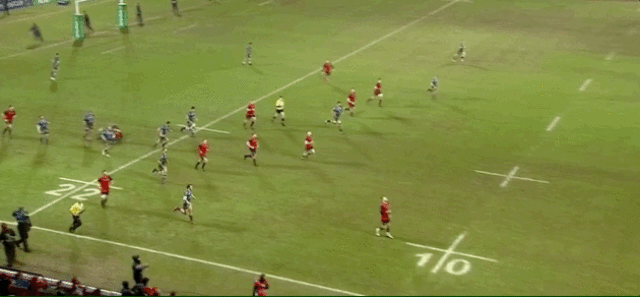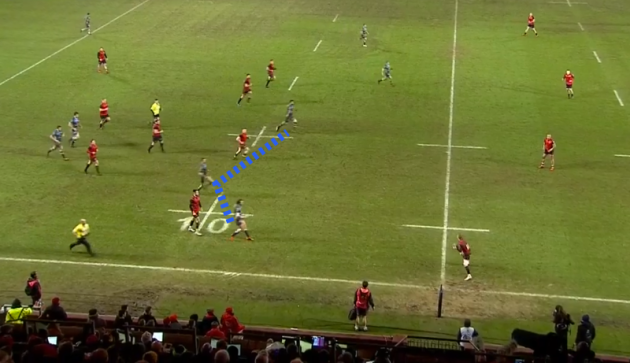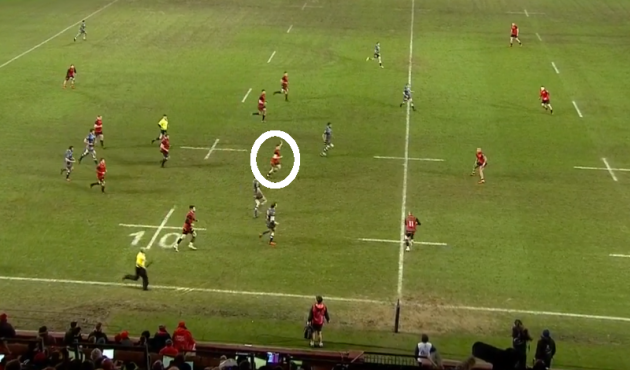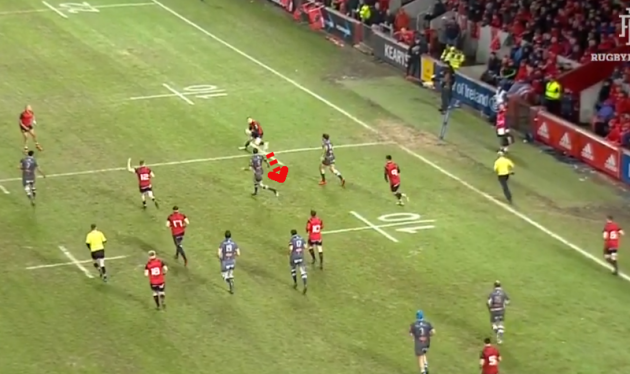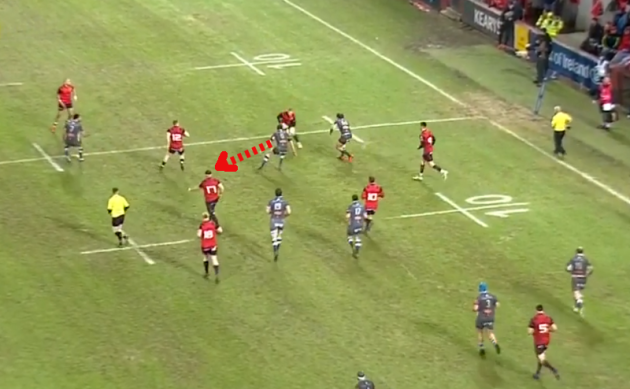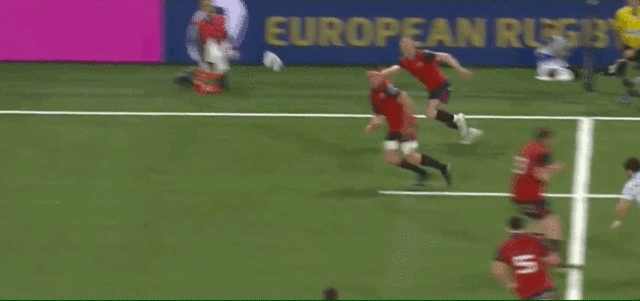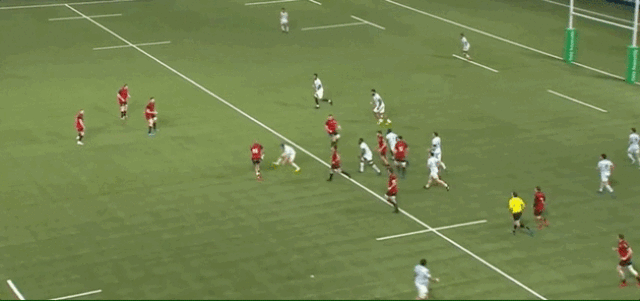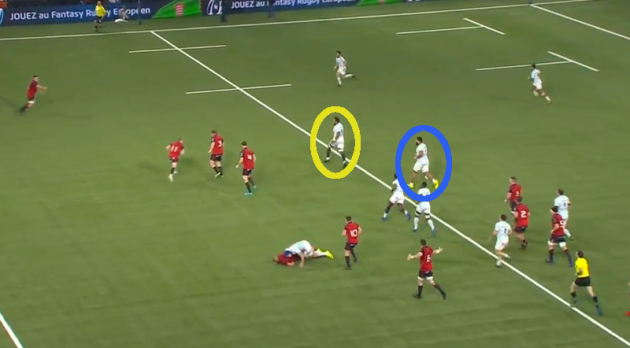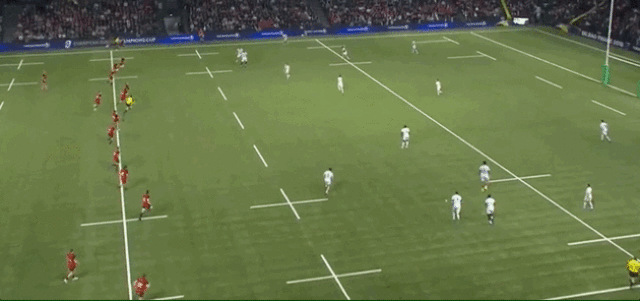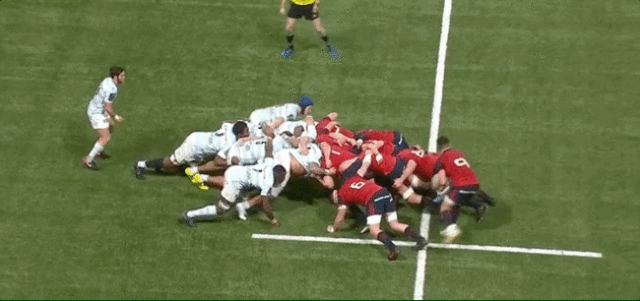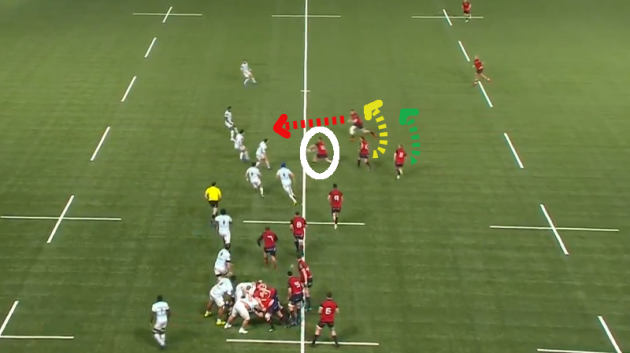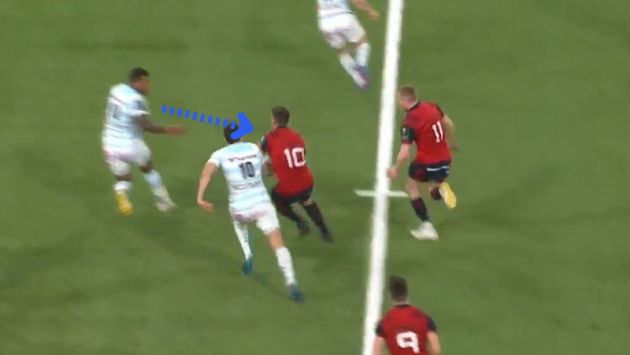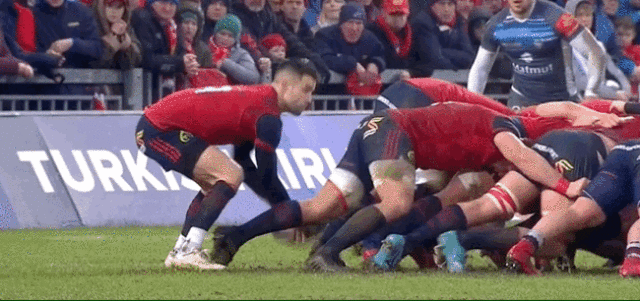SOMETIMES, A PLAYER hits the kind of form where his team-mates are simply looking to get the ball into his or her hands as early and as often as possible.
Keith Earls has been that man for Munster recently and you can see and feel a lift in the players around him and their supporters every single time the ball finds its way to him.
The 30-year-old is in some of the finest form of his career, which bodes well for Ireland ahead of the Six Nations.
Obviously, every team in the world is looking for the best way to give their key attacking weapons an opportunity to use their skills, but Earls is more than capable of creating opportunities for himself.
Click here if you cannot view the clip above
His brilliance on kick return against Castres on Sunday, teeing up Simon Zebo for his try, is one of the latest prime examples.
Rory Kockott clears for the French side but doesn’t find touch and Earls keeps the ball in play. Immediately, he is looking for opportunity and the disjointed Castres chase line presents him with exactly that.
We can see below that the three closest chasing players [linked by the blue line] have not joined up into a solid wall of defence coming forward. Though that can sometimes happen by design – see Saracens – it invites an Earls break here.
Castres’ ‘spacing’ is also not ideal, with a wide gap already evident to the left shoulder of the second defender in the disjointed line we can see above.
Earls spots that instantly himself, but also gets a little cue from the retreating Rory Scannell, as we can see below.
Scannell has his left arm raised, looking to draw Earls’ attention to that opening in the Castres chasing line.
Earls is already making his move, having pumped a dummy pass to Simon Zebo just to ensure Steve Mafi – the third Castres defender in - continues to advance on the fullback.
Moving infield away from the touchline, Earls steps hard off his right foot to dart at the right shoulder of Castres lock Thibault Lassalle – he’s picking on a slower-reacting forward here.
That threat to his right shoulder lures Lassalle into planting his feet and sitting onto his heels, expecting to make a tackle there.
But within a split second, Earls is already stepping powerfully back off his left foot, taking himself across the briefly prone Lassalle.
Lassalle does his best to react, but Earls is too quick and accelerates through the French lock’s tackle attempt, all arms, having totally evaded Lassalle’s shoulders.
Having been moving quite laterally, Earls then straightens up and runs hard at the left shoulder of Alexandre Bias, taking the ball right up to the tackle point before rewarding Simon Zebo for his excellent support line.
Click here if you cannot view the clip above
We can see above how hard Earls gets hit for his troubles, but it’s typically selfless play from a man who has taken a fair few thumping tackles to the benefit of his team-mates over the course of his career.
Freed to get up to top speed, Zebo does the rest with a fine finish through the slightly disinterested final two tackle attempts.
Earls’ contribution here is very similar to the manner in which he kick-started his own try against Racing 92 the weekend before.
Click here if you cannot view the clip above
In this example, Earls has to retreat in order to gather the ball after a loose Zebo pass, but he instantly creates something when he’s in possession.
The Ireland international accelerates through Maxime Machenaud’s tackle attempt, firing off a little fend on his way, before using similar dancing footwork to evade two would-be tacklers.
He then draws in Edwin Maka and passes into space, and Munster have a fine try-scoring chance here until Ben Tameifuna slaps the ball down. The Racing prop is lucky not to be carded but is helped by Conor Murray quick-tapping the penalty.
And just 24 seconds later, Earls is back on the ball and making things happen again.
Click here if you cannot view the clip above
Zebo’s pass is ideal this time, and then Earls reads the opportunity perfectly again.
He recognises that – as in our other example – he can expose the lack of mobility of a tight five player. Earls can see back row Leone Nakarawa [yellow below] and heavy lock Maka [blue below] in front of him.
Nakarawa is relatively agile, but Earls knows he can expose Maka, who has had to cover quite a lot of ground over the course of this passage of play.
Earls initially moves towards Nakarawa’s outside shoulder, but then again we see that sharp step off his left foot to take him back inside.
Maka doesn’t have the pace or stamina left to cover across to Nakarawa’s inside shoulder and Earls scorches past him, hitch-kicking out of the despairing tackle attempt from Maka and then surging through Louis Dupichot’s effort to sweep across.
Clearly, Earls’ vision, footwork and pace are important but his decision-making in both these scores is also excellent – as he draws in players and passes to better-placed team-mates.
Earls always brings work rate too, and this second example gives us a glimpse of that if we rewind 1 minute and 50 seconds before he actually scores.
Click here if you cannot view the clip above
We can see Earls hurtling after Ian Keatley’s restart and making the tackle on Racing 92 receiver Yannick Nyanga.
The tackle is high and Earls is fortunate to escape sanction, but he shows his work rate by bouncing off the ground and looking to counter-ruck immediately.
He doesn’t force a turnover or any panic for Racing, but it shows his willingness to work hard.
After he makes his way back downfield and Racing kick the ball to Munster, Earls is waiting wide on the left and concludes the entire passage with his decisive finish.
Earls’ skill level on top of that work-rate base make him the high-quality player he is, and his form at the moment is part of Munster’s ever-growing ability in unstructured passages of rugby – where they needed to improve.
As has been well documented, Munster’s attack under Rassie Erasmus never truly fired against the very best teams.
With Johann van Graan on board now, it appears there has been a renewed focus on taking try-scoring chances in instances like those above, the so-called ‘transitions’ between attack, defence and kicking.
Earls is an effective weapon there, but he’s also dangerous from set-piece situations, as we see below.
Click here if you cannot view the clip above
Keatley delays his pass to Earls expertly here, before the Munster wing throws an audacious and accurate offload in front of Zebo.
With Racing 92 wing Marc Andreu in between Earls and Zebo, the offload is even more impressive, as Earls needs to put it beyond the reach of Andreu but within range of Zebo’s run – his accuracy is perfect.
And Zebo’s one-handed tip-on to Andrew Conway continues a sensational chain of skills from Munster’s ever-improving backline.
Those who read our piece on Munster’s promising set-piece attack before the Racing 92 match might recognise this scrum attack as exactly the same one that cut Connacht apart for Earl’s try the week before, albeit from the other side of the pitch.
As before, Scannell [circled in white below] acts as first receiver, Chris Farrell [red] runs a hard, straightening line, while Keatley [yellow] and blindside wing Earls [green] bounce out the back.
It appears that Munster’s intention here is always to test Virimi Vakatawa – playing at outside centre but not defensively confident there – and that’s exactly what they do as Keatley draws Vakatawa in briefly [as indicated by blue below] before passing to Earls.
That allows Earls just enough space to get outside Vakatawa and offload as the French international makes a diving tackle.
It’s great execution of the set-piece attack from Munster once again, and this particular move is something they’re going to time and time again under van Graan and the increasingly influential Felix Jones.
Below, we see it in action against Castres on Sunday, this time with Scannell opting to carry himself.
Click here if you cannot view the clip above
The key for Munster on this play is that they have multiple options – Scannell carrying, Farrell on a short pass, Keatley out the back door to run himself or Keatley out the back door to feed the blindside wing, or even Keatley out the back door to skip to his fullback.
And the point is not solely around this specific play, but Munster’s inventive approach on set-piece.
We’re seeing lots of intelligence and innovation, ideas like the one below against Racing on phase two of a pre-planned ‘power play’ from a lineout in the opposition half.
Click here if you cannot view the clip above
The thinking from Munster here is so sharp.
They have presumably identified pre-game that Racing’s defensive set-up will sometimes leave this space just in behind their frontline in this area of the pitch, with their two backfield defenders [blue below] in wider positions.
Murray’s kicking accuracy can be depended on more often than not, and the timed runs from Earls [yellow] and Conway [red] in chase show us the pre-planned nature of this attacking play.
Munster’s wings are up flat and hounding after the kick even before it has left Murray’s boot, just keeping themselves onside, but giving themselves a major advantage over Racing’s reactive defence.
On a normal grass surface, the kick would be absolutely perfect but on this 4G pitch, it bounces that little bit higher and just evades Conway.
Even though it’s a miss, this incident underlines the quality of thinking going into Munster’s attack. We are seeing examples like this all the time, from lineouts featuring scrum-half Murray, to trick mauls, to multi-option scrum attacks and more.
A huge number of tries in rugby are scored on the very first or seconds phases of possession, either in those unstructured situations on kick return and turnovers, or off set-piece platforms.
The evidence suggests Munster are placing a great emphasis on these areas under van Graan and the results are promising. It will be intriguing to see what himself and Jones come up with later this season, but there’s little doubt Earls will feature prominently.
For the coming weeks and months, the Munster man’s form should be to Ireland’s benefit.
The42 has just published its first book, Behind The Lines, a collection of some of the year’s best sports stories. Pick up your copy in Eason’s, or order it here today (€10):
